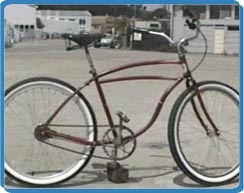|

|
|
Frames & Materials
Page: 1 of 4
|

The pneumatic tire and the chain drive, followed by the development
of gears, revolutionized bicycling in the later 1800s. In the last fifteen
years, there has been a revolution of sorts in the development and use of
new materials for building frames. It wasn't that long ago that frames were
made out of cast iron or even wood. Today bicycles are made out of exotic
materials such as titanium, aluminum, and carbon fiber. Bicycle frames in
the 1990s are lighter and stronger than ever before.
|

|
A racing bicycle frame with parts of the frameset indicated.
|
|

|
An early swiftwalker and rider draws a crowd in New York City in 1827. Officially
the swiftwalker received a less enthusiastic welcome. A city law was passed
banning the invention from public places and sidewalks.
|
|
Swiftwalkers
German Inventor Karl von Drais is credited with developing
the first bicycle. His machine, known as the "swiftwalker," hit
the road in 1817. This early bicycle had no pedals, and its frame was a
wooden beam. The device had two wooden wheels with iron rims and leather-covered
tires. As the name suggests, a rider walked on top of the bike with his
feet leaving the ground during descents.
|
|
Age of the Velocipedes
While it might seem simple and obvious now, getting the
rider's feet completely off the ground was a major step (excuse the pun)
forward in the development of the bicycle. The rider used pedal-cranks attached
to the hub of a wheel to propel himself. There is a dispute as to who invented
the machine that became known as the "velocipede," but there is
no question as to its impact.
|
|
The velocipedes of the mid 1800s consisted of two wooden tires,
a front fork, handlebars for steering, a saddle on wooden frame, and pedals
on the axle of the front wheel. The velocipede also received a nickname,
the "boneshaker." With the rider now completely mounted on the
bicycle, he felt all of the bumps--the early velocipedes were not equipped
for absorbing vibrations. It wasn't until the development of the pneumatic
tire that this problem was effectively addressed. At around the same time
the pneumatic tire was developed (1888), lighter materials began to be used
for frames, improving the ride dramatically.
|
|
Materials for Frames
By the time the modern "safety" bicycle was developed
in the late 1800s most frames were made with steel tubing instead of wood
or cast iron. While the steel bicycles were quite strong they were also
very heavy. It was not uncommon for a bicycle of that era to weigh in at
over 80 pounds (36.28 kg.).
|

|
A classic "cruiser" safety bike built in 1957. The frame is made
of steel and the bike weighs nearly 50 pounds (22.68 kg).
|
|
Steel frames are still used today, but the tubing has thinner walls and
weighs considerably less. Modern frame makers such as Paolo Salvagione use
a variety of materials for highly specialized bikes. Paolo uses steel, aluminum,
titanium, and even carbon-fiber. Which material he uses depends on the type
of bike, the rider's preference, and the cost. We asked Paolo to tell us
about the unique qualities of each material.
|
|
|
Frames & Materials
Page: 1 of 4
Select "Forward" below to continue
|

©
Exploratorium
|

